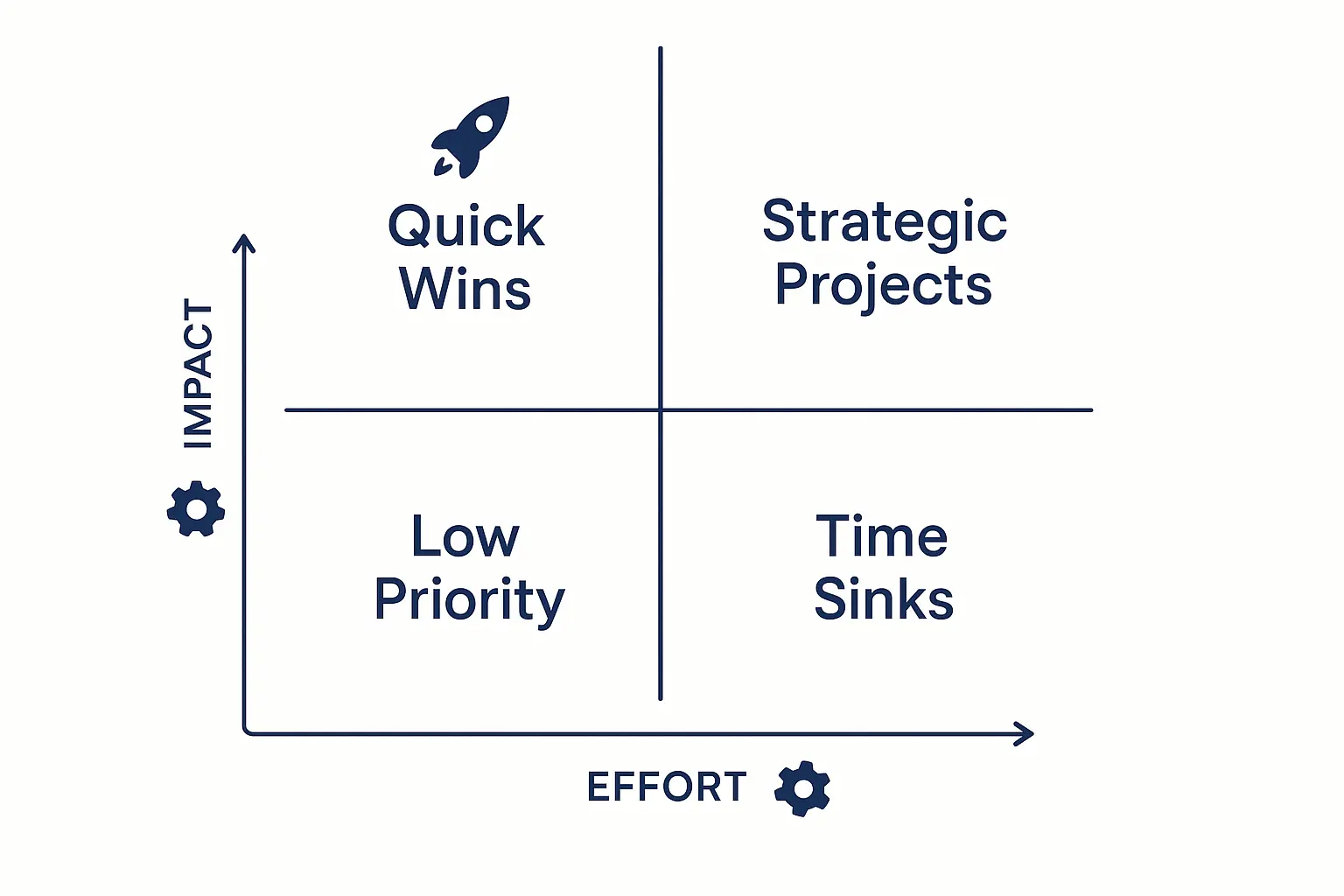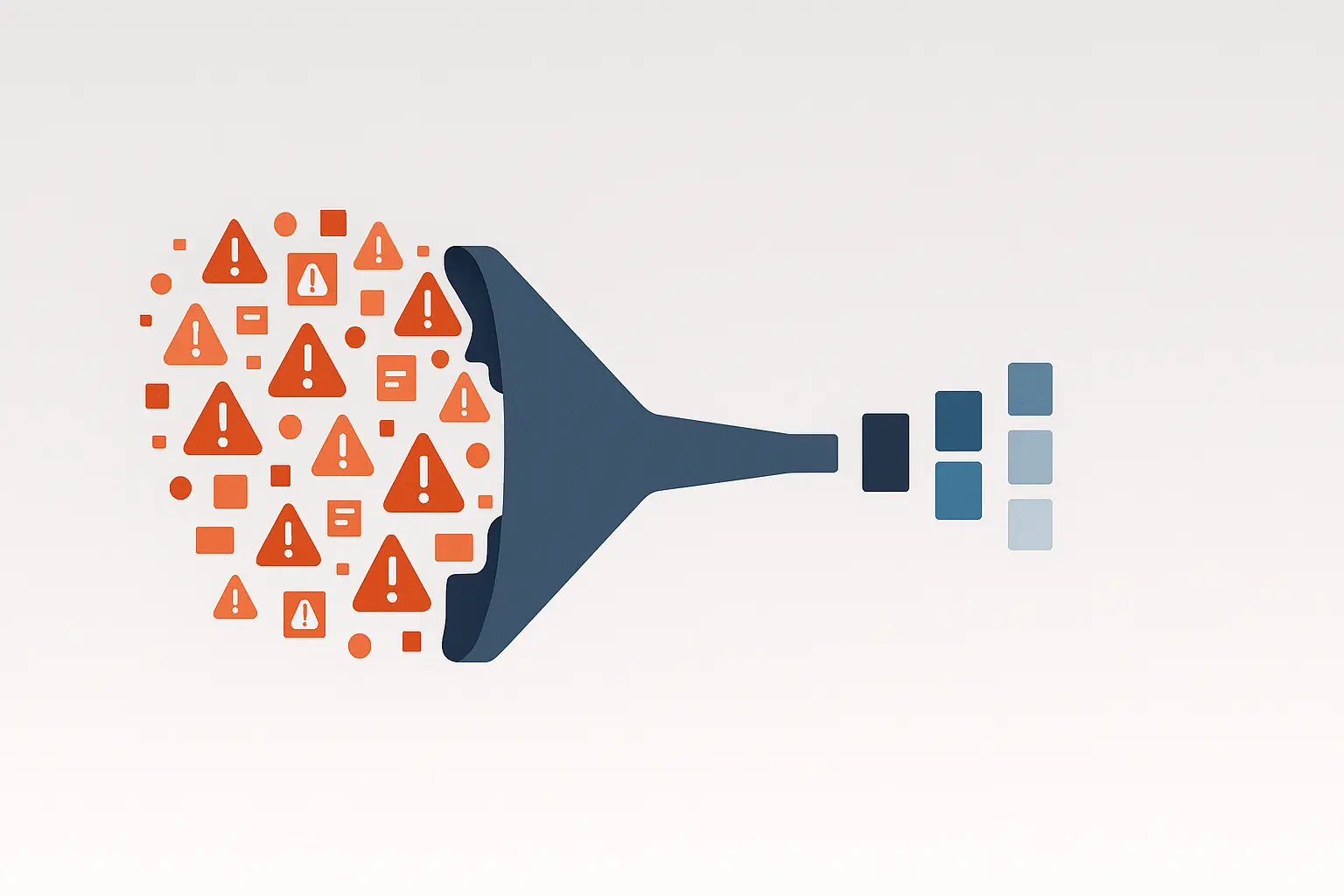You did the right thing. You ran a comprehensive, automated technical SEO audit on your client’s website. The tool crawled every page, analyzed every link, and produced a beautiful, color-coded report.
And it’s 150 pages long.
The dashboard is a sea of red alerts, orange warnings, and a seemingly endless list of “opportunities.” You’re looking at hundreds, maybe thousands, of flagged issues. Now what? Do you forward this novel-length PDF to your developer and hope for the best?
That approach is a recipe for inaction. Overwhelmed developers, limited budgets, and competing priorities mean a giant, un-prioritized list of SEO fixes will likely end up collecting digital dust.
The real value of an automated audit isn’t the data dump; it’s the human expertise that translates that data into a strategic action plan. This is where the Triage Protocol comes in—a simple framework for transforming that chaos into a clear, effective roadmap that developers will actually implement.
Why a Prioritized List is Your Most Powerful SEO Tool
Before we dive into the “how,” let’s talk about the “why.” Simply running an audit isn’t enough. In fact, research shows that 57% of marketing professionals worldwide cite technical website optimization as their most effective SEO tactic.
It’s not just about pleasing Google; it’s about creating a stable foundation for all your other marketing efforts to succeed.
Prioritization is critical for three main reasons:
-
Limited Developer Resources: Your development team is already juggling new features, bug fixes, and security updates. Handing them a list of 200 “SEO issues” without context is like asking a chef to cook every dish on the menu at once. It’s inefficient and guarantees nothing important gets done first.
-
Crawl Budget Optimization: Think of Googlebot as having a finite amount of time to spend on your website—its “crawl budget.” If it wastes time navigating broken links, redirect chains, and server errors, it may never get to your most important pages. A prioritized plan ensures you’re clearing the path for Google first.
-
Direct Business Impact: The business impact of technical fixes varies wildly. Some issues, like a slow checkout process, directly kill conversions. Others, like a few missing image alt tags on a blog post from 2015, have a much smaller impact. Your job is to connect technical fixes to business outcomes, and that starts with tackling the biggest levers first.
The Triage Protocol: A 3-Bucket System for Sanity
The goal of the Triage Protocol is to sort every issue from your audit report into one of three simple buckets. This act of sorting is where your expertise shines, moving you from data reporter to strategic consultant.
The three buckets are:
-
Bucket 1: Critical (Fix Now): These are the digital emergencies—the “house is on fire” issues that are actively harming the site’s ability to be found and used.
-
Bucket 2: High-Impact (Fix Next): These are the growth levers. They aren’t emergencies, but fixing them will lead to tangible improvements in rankings, traffic, and user experience.
-
Bucket 3: Opportunistic (Fix Later): This is the “nice-to-have” list. These are valid issues, but their impact is lower, or they require significant effort for a minor gain.
Let’s break down what goes into each bucket.
Bucket 1: Critical Fixes – The Digital Emergencies
These are the non-negotiable, top-priority items. If you see any of these, it’s time to sound the alarm, as they directly prevent search engines from indexing your content or stop users from converting.
Common Critical Issues:
-
Indexing & Crawlability Blocks: This is the most urgent category. Look for incorrect robots.txt directives that block important sections of the site, or widespread noindex tags that tell Google to ignore your pages entirely.
-
Major Server Errors (5xx): If key pages are returning a server error, they are invisible to both users and search engines.
-
Security Warnings: Issues like an expired SSL certificate or mixed content warnings on pages that collect user information can destroy user trust and lead to penalties.
-
Broken Core User Journeys: If the checkout process is broken or a lead form can’t be submitted, you’re not just losing rankings—you’re losing money.

Bucket 2: High-Impact Fixes – The Growth Levers
Once the fires are out, you can focus on renovations that add real value. These issues are directly tied to performance and user experience on your most important pages.
Common High-Impact Issues:
-
Poor Page Speed: For every additional second it takes a mobile page to load, conversion rates can drop by up to 20%. Focusing on improving Core Web Vitals and load times for key “money” pages delivers a massive ROI.
-
Mobile Usability Problems: With over half of all web traffic coming from mobile, a clunky mobile experience is unacceptable. In fact, 61% of mobile searchers say they are more likely to contact a local business if they have a mobile-friendly site. Fixing issues like tiny text or clickable elements that are too close together is a direct investment in your customer base.
-
Widespread Duplicate Content & Canonicalization Issues: This clears up confusion for search engines. When Google sees multiple versions of the same page, it doesn’t know which one to rank. Implementing canonical tags tells Google which page is the “master copy,” consolidating your ranking power. This is a core part of the ongoing optimization that effective white-label SEO services manage.
-
Poor On-Page SEO on Key Pages: Missing or unoptimized title tags, meta descriptions, and headers on your most valuable service or product pages are significant missed opportunities. These elements are your primary tools for telling both users and search engines what a page is about.

Bucket 3: Opportunistic Fixes – The Polish and Shine
This bucket is for, well, everything else. These are valid issues that should be addressed when time and resources permit, but they aren’t holding your site back in a major way.
Common Opportunistic Issues:
-
Broken External Links: It’s good practice to fix links pointing to now-defunct external sites, but a few of these won’t tank your rankings.
-
Missing Alt Text on Non-Critical Images: Alt text is important for accessibility and image search, but prioritizing it for decorative images on a minor page is less critical than fixing a broken checkout flow.
-
Minor Schema Markup Opportunities: Adding structured data (schema) can help you get rich snippets in search results, which is great for click-through rates. However, it’s an enhancement, not a foundational fix.
-
Long Redirect Chains (3+): These can slightly dilute link equity and slow down crawl speed, but they are rarely a top-tier emergency unless they break a key user journey.
Managing this long tail of smaller optimizations is where many agencies get bogged down. This is often where exploring SEO outsourcing for agencies can free up your internal team to focus on high-level strategy and client relationships.

From List to Roadmap: Communicating with Your Dev Team
Your job isn’t done once the buckets are filled. The final, crucial step is to translate your prioritized list into a clear, actionable roadmap for your development team.
Never just forward the audit PDF.
Instead, create a simple spreadsheet or a set of tickets in a project management tool like Jira or Asana with these columns:
-
Issue: A clear, concise description (e.g., “404 Error on About Us Page”).
-
Priority: Critical, High-Impact, or Opportunistic.
-
Business Impact: Explain why it matters in plain language (e.g., “This prevents users from learning about our company and breaks our main navigation menu”).
-
Example URLs: Provide 2-3 specific links where the issue can be seen.
-
Proposed Solution: A clear instruction (e.g., “Please redirect this broken URL to the new contact page: /contact-us/”).
This approach respects the developer’s time, connects your requests to business goals, and dramatically increases the likelihood of implementation.
FAQ: Your Technical SEO Triage Questions Answered
How often should I run a technical audit?
For most sites, a deep audit is valuable quarterly, with a lighter monthly crawl to catch new critical issues. High-traffic e-commerce sites may need more frequent monitoring.
What’s the difference between an “error” and a “warning” in these tools?
Think of errors as confirmed problems that need attention, like a broken link or a 500 server error. Warnings are often potential issues or deviations from best practices that require your expert judgment to determine if they actually need to be fixed, like a slightly-too-long title tag.
Can I ignore the “Opportunistic” bucket forever?
Not forever. The best practice is to schedule a “clean-up” sprint with your dev team once or twice a year to knock out a batch of these lower-priority items. It’s good digital hygiene and prevents small issues from piling up into bigger problems.
Is a 100/100 site health score really the goal?
No. A perfect score is often unrealistic and unnecessary. The goal isn’t a perfect report card; it’s a website that provides a great experience for users and is easily understood by search engines. Focus on fixing the issues that have a real-world impact, not on chasing a vanity metric.
Beyond the Audit: From Data to Strategy
An automated audit is a powerful diagnostic tool, but it’s just the first step. It can tell you what is broken, but it can’t tell you why it matters or what to fix first.
That’s where your expertise comes in. By applying the Triage Protocol, you transform an overwhelming data dump into a strategic, prioritized roadmap. You shift the conversation from “here are 500 things that are wrong” to “here are the three most important things we need to fix this month to improve conversions.”
This strategic approach not only gets better results but also demonstrates immense value to your clients. And if you’re looking to consistently apply this level of strategic oversight across multiple clients without overwhelming your team, finding the right agency SEO partner can provide the scalable systems and expertise to make it happen.

